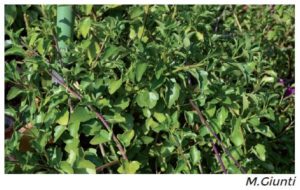 Common name: Creeping groundsel
Common name: Creeping groundsel
Scientific name: Senecio angulatus
Brief description: An evergreen creeper-liana plant with fleshy, bright green, shiny leaves without down that resemble the shape of ivy with a scalloped edge. It has abundant autumnal blooms with yellow, five-petal flowers the size of small daisies.
Biology and ecology: Like many South African species the ragwort is well suited to the Mediterranean climate, rather dry and temperate. It reproduces via seeds that are transported, sometimes notable distances, thanks to the wind, but its vegetative diffusion is the most characterising aspect. The high growth capability of the liana and climbing roots allows the species to form dense carpets on the ground and on walls, on ruins, on embankments or climb up to the treetops.
Distribution in the Tuscan Archipelago and introduction: The creeping groundsel originates from South Africa and was introduced for ornamental purposes, given that it adapts very well, does not require particular care and is appreciated for its late bloom. In the Archipelago it is present and widespread in all the islands, except for Montecristo.
Impact: The species threatens native plant communities, thanks to its impressive ability to quickly colonise wide surface areas, suffocating and taking the place of local plants.
Management in protected areas: The Park is following a monitoring plan for the control of any vital sprouts on the Island of Pianosa, where it was eliminated thanks to the project “Montecristo 2010”. On the Island of Giannutri, however, still with the financial support of the European commission, operations have just been started aimed at countering its spread.




